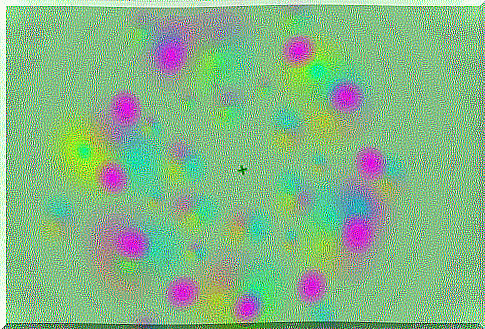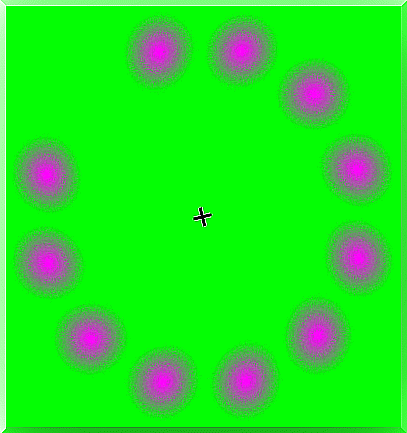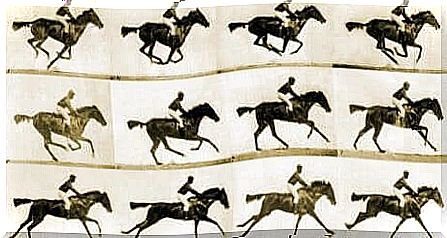Phi Phenomenon, Optical Illusion

The Phi (φ) phenomenon is the optical illusion generated by our brain that a fixed figure actually appears to be in motion. The Gestalt current coined and defined the term in 1912 with the aim of demonstrating a fundamental concept: perception goes beyond our senses, of what we see or hear. It is, in fact, a mere perception of our brain.
Undoubtedly the starting point for interesting reflections. You will probably have those images full of flashy shapes and colors that seem to tremble, move and sway timidly towards us. Discovering that that movement is not real leads us to question many things.
Thinking that a perceived stimulus does not correspond to the real one can make us hesitate and believe that something is wrong with us. Is the problem in our senses? In our view? Absolutely not, and the Phi phenomenon and optical illusions explain it to us .
However, as US neuroscientist David M. Eagleman, author of books such as Incognito: The Secret Lives of the Brain points out , the first lesson we need to learn about our senses is that you have to trust them 100%. The mere fact of seeing something with the eyes is not indicative of its real existence.
The brain interprets, constructs and disassembles, invents and introduces axioms into our mind only to make things acquire a certain logic. This happens, for example, when it perceives gaps or flaws in what we are seeing with our eyes. As we shall see, this discovery was instrumental in the development of Gestalt psychology.

The Phi phenomenon underlying the Gestalt
It was Max Wertheimer (1880-1943), founder of the Gestalt current, who first described the so-called Phi phenomenon in the field of science. He did so through a study entitled Experimental Studies on the Perception of Motion (1912), with which he laid the foundations of the psychology of perception.
As with most discoveries, it was by chance that Wertheimer stumbled upon a strobe in a train station, sparking his curiosity about that strange phenomenon.
He knew that the game of geometric figures was not in motion, yet his eyes seemed to deceive him. He called it the phenomenon φ to distinguish it from β (beta), according to which a stimulus moves according to a real and logical capacity. There was something odd about those figures and Dr. Wertheimer decided to find out what it was.
Phi phenomenon and false movements, a mistake of the brain?
The Phi phenomenon differs from classic optical illusions in several respects. First, it is related to a succession of similar figures. Still images that are reproduced in front of our eyes one by one, at a determined speed, giving us the impression of being in motion.
- Max Wertheimer showed that when exposed to a succession of static images at a concrete speed, our brain interprets them as something in motion.
- It is a phenomenon also linked to the persistence of vision. This concept is based on the idea that images remain “imprinted” in the retina for a fragment of a second. If we pass so many images in front of the human eye quickly, the brain is no longer able to differentiate and isolate them.
- Thus ends up by interpreting (erroneously) that it is the same object in motion.
It should be noted that Wertheimer’s research and his theory on the Phi phenomenon contributed to the development of cinema thanks to the technique of successive frames. It was Hugo Münstenberg who took an interest in the idea and gave it shape in 1916.

Starting point of the Gestalt
It is important to underline that the Phi phenomenon did not represent an innovation for the world of scientific psychology. In the field of photography this type of perceptual experience was already known. In fact, one of the best known exponents was the British photographer Eadweard Muybridge (1830-1904).
His work was groundbreaking for the time. It was only 1878 and Muybridge had already invented what I call chronophotography. One of his best-known works consisted in capturing the movements of a horse and its jockey running through the use of 24 cameras lined up along the track.
After developing and revealing the images, he noticed that making them follow each other at a certain speed produced the effect of real motion.
So if this phenomenon was not new to some, Wertheimer’s studies marked the turning point in the field of Gestalt. Let us not forget that the psychological current laid the foundations for the study of sensation and perception.
According to theorists such as their own Wertheimer and Wolfgang Kohler or Kurt Koffka, our perceptions are not isolated stimuli.

The brain always tends to group what it sees, to create a whole based on a sense of coherence and an interpretative logic. It is precisely for this reason that it leads us to believe that a succession of images are not isolated figures, but the same object in motion. It is a way to economize and simplify efforts.
But, as we understand, it is not something real. As neuroscientist David M. Eagleman argues, it’s always good not to trust 100% of everything your brain makes us believe.









